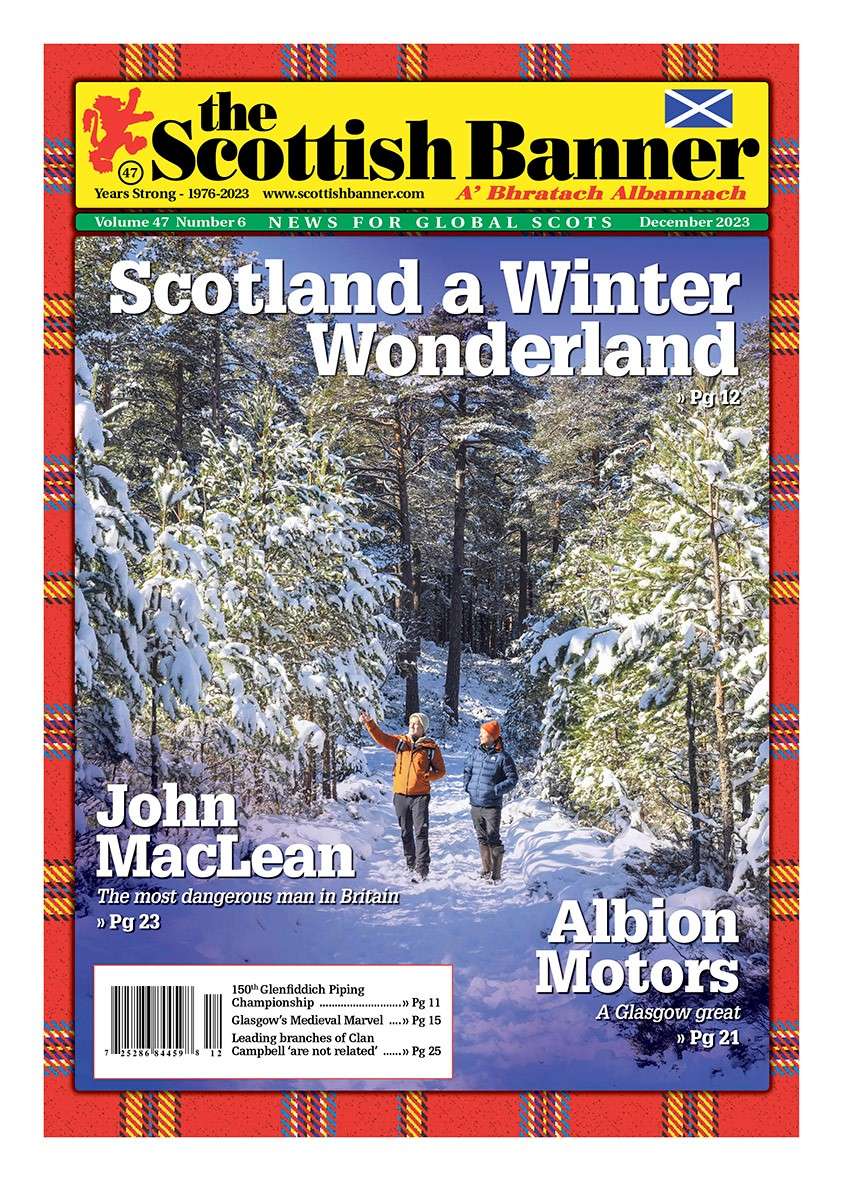December – 2023 (Vol. 47, Number 06)
The Banner Says…
Christmas traditions of Scotland’s isles
The month ahead is often busy for many with Christmas and Hogmanay events, and catching up with family, friends and colleagues. Most of us eat
a bit more than we should, enjoy a dram, or two, and hopefully also get some time to rest and reset for the year ahead. Children across the world also are filled with the excitement and magic that only Christmas can bring.
Krampus
The Christmas we all know today, with excited children lining up to sit on Santa’s knee and put in their order for the big day, it may come as a surprise to many that in one part of Scotland a Christmas tradition was to frighten the children.
On the Hebridean island of Islay fear was put into any children, who behaved badly, that a creature would appear during the festive season to visit them. Parents would tell their kids terrifying tales of the Krampus, a goat-demon monster who took great joy in terrifying naughty youngsters.
Known on the island as the Crom Dubh na Nollaig (the dark crooked one of Christmas) this monster would howl down people’s chimneys in the night and beat kids with birch branches. The Scots somehow incorporated the Krampus legend from Europe where the name derives from the German word Krampen, which means to claw. Krampus is thought to date back to Pagan times as a ritual around the winter solstice period and was popular mainly in Germany, Austria and Switzerland. How the Alpine legend made its way to Islay is not known, but I would imagine that the children of Islay were quite well-behaved.
Whipkül
Both Orkney and Shetland share their love of Yule bread. This tasty tradition is linked to a Celtic druid belief that the sun stood still for the mid-winter period, so the Yule bread was made in a circle, which represented the sun. The bread included caraway seeds to represent Sìdhe, or the winter spirits, in Celtic folklore. It was often traditional for the baker of Yule bread to hide something in the loaf, like a trinket, and who ever finds it has good luck for the year ahead.
Shetland’s answer to Eggnog has to be Whipkull/Whipkül. With its origins in Scandinavia, Whipkull is a traditional drink made with cream, eggs, nutmegs and rum (however people have been known to substitute that for whisky or another preferred spirit). This drink, often accompanied with a nice piece of shortbread, has been known as a dessert to be consumed at the end of the Yule feast and even a breakfast drink on New Years Day-what a way to start the year!
In this issue
If you happen to find yourself in Scotland this holiday season you may be interested in our feature on Scotland as a winter destination. I have been to Scotland countless times over winter and can confirm there is much on offer for the visitor. Crowds are down and though not everything is open, much is, and the scenery is always on display regardless of those shorter and darker days.
The Albion Motor Car Company was founded in Glasgow in December 1899 and was an iconic business for Scotland. From its inception through to the late 20th century Albion Motors was a major employer of generations of local people, producing at first cars, then commercial vehicles at its Scotstoun site for over 65 years.
Thought to be Glasgow’s oldest building Provan Hall overlooks Auchinlea Park in Easterhouse. It was built in the 15th century as a hunting lodge for Glasgow Bishops. This hidden historic gem recently had a £3.5million restoration and I will be sure to add it to my list when next back in Glasgow.
Foula
For most of us once Christmas and Hogmanay are finished with, we feel we need a wee break as we roll into January after all the festivities. However, for one Scottish island the festivities are just beginning. The island of Foula lies 20 miles from the Shetland coast and has been also known as Ultima Thule, or ‘the edge of the world’.
Its population of approximately 35 residents follows the Julian calendar rather than the Gregorian calendar, which means they celebrate Old Christmas (or as it is known Yule) on January 6 and New Year’s Day on January 13. As the rest of the UK adopted the Gregorian calendar in 1752 it does not appear that Foula is in any rush to catch up with their mainland cousins, and for me that is just another reason Scotland is just so amazing.
I wish you and your Clan a wonderful and safe holiday season. Merry Christmas, or to our Gaelic readers Nollaig Chridheil, and thank you to all our readers, advertisers and friends for their support during the year.
Have you enjoyed a Scottish island holiday tradition? Do you have any favourite Scottish customs at the festive period? Do you have you any comments from the content in this month’s edition? Share your story with us by email, post, social media or at: www.scottishbanner.com/contact-us
#ScottishBanner, #TheBanner
The Scottish Banner is more reliant than ever on our readers helping us to provide you with our unique content by buying a copy of our publication, regardless if by print or digital subscription or at a retail outlet.
We appreciate your support and hope you enjoy this edition.

